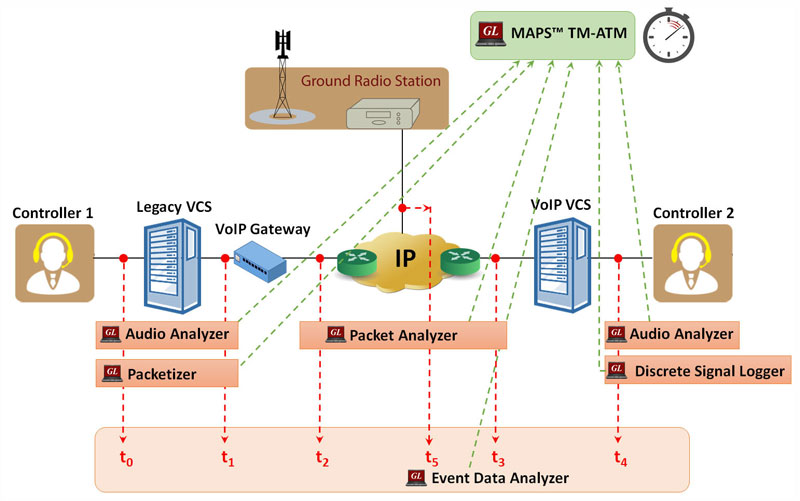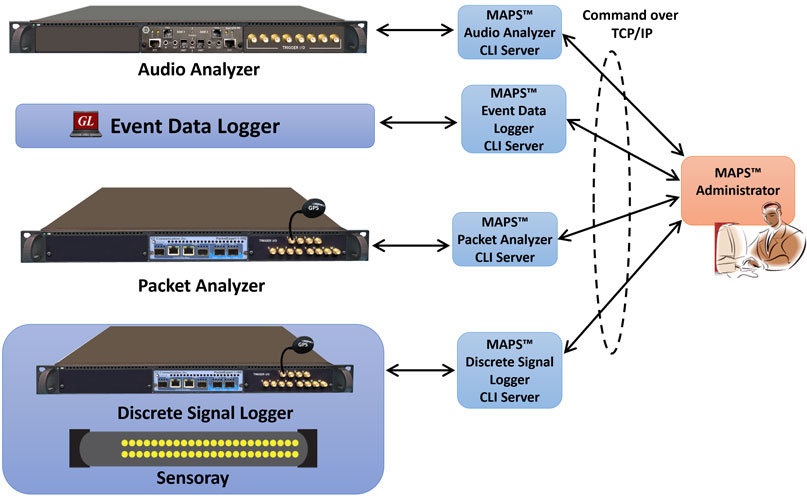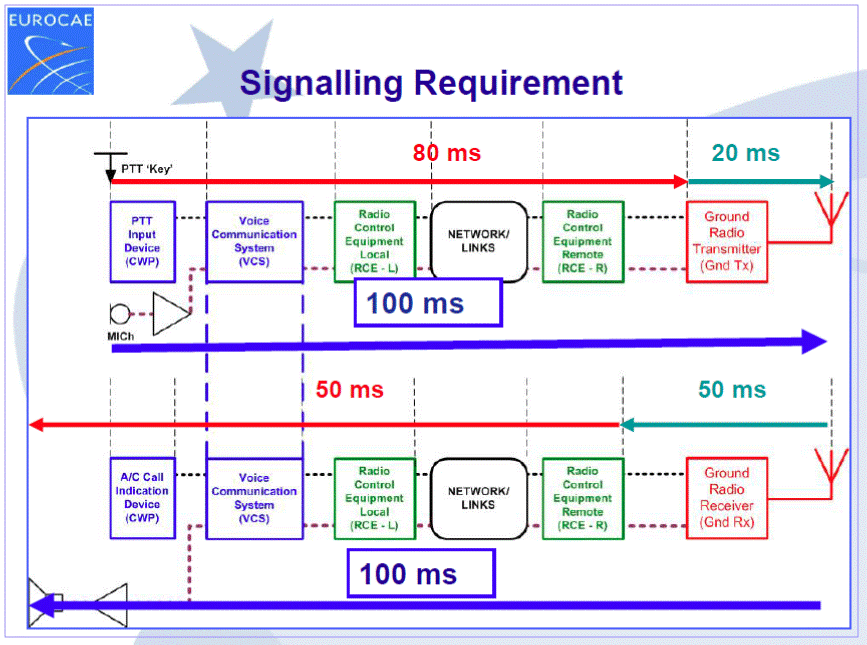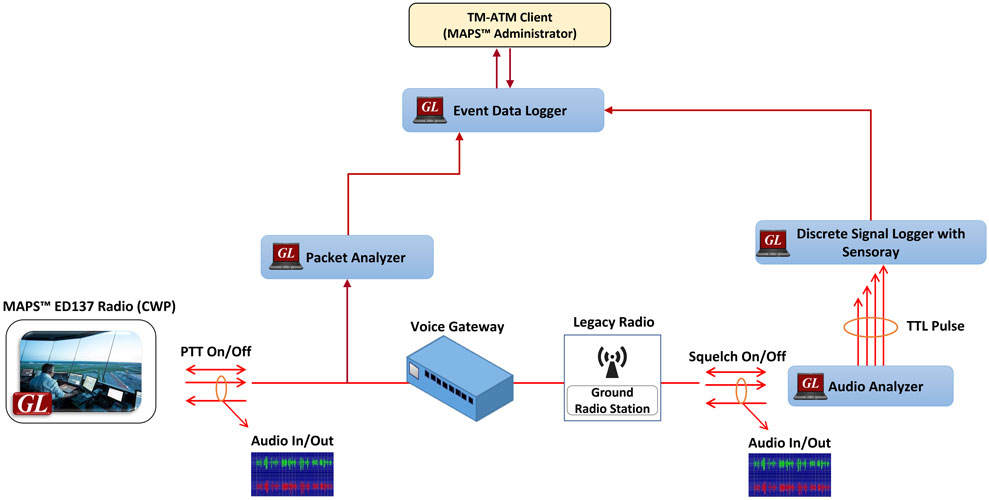Timing Measurement Tools
for IP Based Air Traffic Management
05th Oct 2018
Welcome to an October 2018 issue of GL Communications' Newsletter providing information and insight into Timing Measurement Tools for Next Generation Air Traffic Management (ATM) Networks.
The latest European Organization for Civil Aviation Equipment (EUROCAE) ED-137 inter-operability standards, address migration and implementation of IP based technology for voice services for air traffic control. Though migrating to an IP network provides convergence advantages for traffic and interoperable network elements from various vendors, it also poses challenges - of variability of different implementations by equipment vendors. Some of these are: Implementation of technologies with varied jitter buffer, packetization, digital signal processing algorithms, VOX operations, and switching from idle to active state. These implementation differences impact end-to-end delay requirements imposed by various industry standard bodies.
Characterizing and limiting these impairments is critical to the performance of the system as a whole. Rigorous methods are needed to precisely measure the delay introduced by each network element as events propagate end-to-end. Recognizing, capturing, timestamping, and correlating events at Analog, TDM and IP interfaces are necessary. Delay measurements should be conducted repeatedly to ensure that the device and network under test is performing as expected consistently over time.
GL has developed MAPS™ TM-ATM (Timing Measurements in Air Traffic Management) test suite to accurately simulate end points in ATM network and provide critical timing measurements for various types of delay occurrences in signaling and voice transmission through the network. It includes all necessary hardware and software to identify, capture, timestamp, and correlate events at Analog, TDM and IP interfaces.

Overview
Some of the standards bodies like the Federal Aviation Administration (FAA) in the USA has published specification for NVS system defining timing requirements in detail, which details the Setup/Teardown Throughput Timing Requirements during Peak Busy Hour (PBH) and Peak Busy Minute (PBM).
Also shown below, are timing requirements extracted from EUROCAE standards document:(ED-136 - VoIP ATM System Operational and Technical Requirements Final Draft 2.0_Oct2008 refer Fig)
As per the industry standards, the following network delay measurements are of primary interest:
- Transmitter activation delay
- Aircraft call indication delay
- Ground transmission voice delay
- Transmitter activation and aircraft call indication loopback delay
- Ground reception voice delay
- Ground transmission and reception voice loopback delay
- Frequency key activation response time and more
To perform these timing measurements, one can setup MAPS™ TM-ATM (Timing Measurements in Air Traffic Management) tools at appropriate strategic interfaces. GL’s MAPS™ TM-ATM is a custom suite of test tools, designed to accurately measure various types of delay occurrence in signaling and voice transmission. It includes all necessary hardware and software to identify, capture, timestamp, and correlate events at Analog, TDM and IP interfaces.
Tools used for Timing Measurement
MAPS™ TM-ATM (Timing Measurements in Air Traffic Management) components can be broadly categorized into two sets based on the underlying hardware:
- Packet Products - Packet Analyzer, Packetizer, Discrete Signal Logger, and Event Data Logger - all these are based on the same GL’s PacketExpert™ Ethernet/IP tester; their functionalities differ through scripts that cater to different needs of test cycle
- Audio Analyzer - this is based on VQuad™ Dual UTA hardware; its main functionality is to simulate radio calls from CWP

All components of TM-ATM are controlled by a centralized component called MAPS™ Administrator (TM-ATM Client). MAPS™ TM-ATM support a client server model, with components acting as servers, the MAPS™ Admin acts as a client and controls all components acting as servers, from a centralised location.
MAPS™ Administrator (MA) uses TCP/IP to send /receive commands controlling the following server applications:
- Packet Analyzer - Packet Analyzer (PA) extends Ethernet testing capabilities of PacketExpert™ 10GX for 10 Gbps and 1 Gbps networks. The hardware unit is a more compact and adds 12-port user-configurable TTL trigger option as an important enhancement.
Packet Analyzer in the network functions like a highly precise Ethernet tap, filtering packets of interest from a bidirectional Ethernet link without disturbing the traffic. It generates output TTL signal pulsesfor every filter match, which can be processed using an external device like Oscilloscope. - Audio Analyzer - is a 4-wire audio device that can connect to a CWP and emulate a controller by activating PTT and transmitting audio. The analyzer can inject and record analog signals at CWP, Radio and VoIP gateway interfaces and generate TTL for different actions (PTT ON, PTT OFF, Send Audio, Detect Audio).
- Packetizer or Discrete Signal Logger - The Discrete Signal Logger monitors the TTL output from the Audio Analyzer and generates a corresponding IP packet indicating a certain event has occurred. The packets generated by the Discrete Signal Logger are named as discreet events and posted to the Event Data Logger.
- EventDataLogger - As seen in the picture above, the Event Data Logger is located at the central location and receives the event packets forwarded from the various Packetizers or the Packet Analyzer systems throughout the network. It timestamps each received packet, decodes the packet to extract information, and updates the Events to the MAPS™ Controller.
Operations
GL's MAPS™ ED-137 Radio and MAPS™ ED-137 Telephone Emulators can simulate Air-Ground calls (as per ED137_1B and ED137_1C: Radio) and Ground-Ground (as per ED137_2B: Telephone) calls. Users can generate hundreds of calls as background traffic to evaluate delay and network performance. GL's Packet Analyzer monitors the line non-intrusively and detects the packets of interest (e.g. first RTP packet with PTT bit set) based on the filters set. For every flter match, the packet analyzer generates output TTL signal pulses and post an event to Event Data Logger. so that the TTL signal (representing the Filter match) can be taken out and processed using an external device like Oscilloscope.
Audio Analyzer injects and records analog signals at CWP, Radio and VoIP gateway interfaces and generate TTL for different actions (PTT ON, PTT OFF, Send Audio, Detect Audio). When an Audio Analyzer performs a certain function, it simultaneously sends a discrete TTL pulse to the Packetizer. When the Packetizer receives this pulse, it creates and transmits a timestamped packet indicating which pulse it received. This packet is filtered out by the Packet Analyzer. Up to 16 filters can be operated simultaneously per port.
This process allows us to get both analog and digital events into the same log for delay measurement. The analog signals can be verified by connecting the TTL I/O Ports to Oscilloscope using SMA cables.
The Event Data Logger is located at a central location and receives the event packets forwarded from the various Packetizers and the Packet Analyzer systems throughout the network. It timestamps each received packet, decodes the packet to extract information, and updates both Discrete Events (from the Packetizer) and Timed Events (from Packet Analyzer) to the MAPS™ TM ATM Admin. It utilizes an onboard memory to temporarily store the received packets before being transferred to the MAPS™ Controller for analysis.
Other Test Tools Useful for Air Traffic Management
- IPNetSim™- GL's IPNetSim™ is an IP Network Emulator that connects to the 2 end points of a WAN link, and acts either as a transparent bidirectional Ethernet link or a simple Ethernet bridge between 2 end points. It emulates a 10 Gbps or a 10/100/1000 Mbps full duplex link. The incoming traffic can be identified into separate user-defined streams in each direction, which can then be impaired (Bandwidth control, Latency/Delay, Packet Loss/ Reordering/ Duplication, Error Insertion) to simulate network malfunctions. Each direction supports up to 16 streams, allowing up to a total of 32 streams in both directions.
- Network Quality Monitoring Tools (ED-138) - GL's PacketScan™ - an All-IP Network Monitoring software offers powerful features to capture and monitor live Ground-to-Ground calls and Air-to-Ground sessions over IP. It captures, decodes, segregates, monitors and collects statistics on all IP calls, as per EUROCAE ED-138.
All data captured are forwarded real-time to NetSurveyorWeb™, a web-based centralized network surveillance system for air traffic monitoring. The application facilitates display of CDRs by connecting to multiple analysis probes such as PacketScan™ through a web server for monitoring physical layer, signaling and traffic.
NetSurveyorWeb™ Lite is an addon to individual protocol analyzers enhancing capability to handle larger volume of data. - Voice Quality Testing (VQT) - GL’s Voice Quality Testing application compares the received voice file against the original and a standard ITU-based voice quality score is derived. While simulating Ground-to-Ground calls and Air-to-Ground sessions, MAPS™ ED-137 sends a voice file over the radio network to an air traffic controller and this voice traffic received at the controller is recorded to a file. The Voice Quality Testing (VQT) software supports the next-generation voice quality testing standard for various network interfaces using POLQA (ITU-T P.863), PESQ (ITU-T P.862).



 Back to Newsletter Index Page
Back to Newsletter Index Page